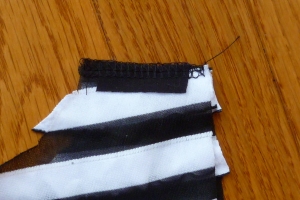
In the two weeks since my last post, Kevin and I took a road trip to Wisconsin and Minnesota where we visited family and friends, and we saw Megan and Chris’s new home. All of those miles traveled and I didn’t visit a single fabric store. Well, just one. However Megan and I did purchase fabric for window valances at IKEA. Though the supply is limited, they have great fabric.
More tips for sewing with pre-ruffled fabric:
As I mentioned in the last post, sewing with pre-ruffled fabric was more challenging than I anticipated. I stopped with tip #7, “Plan for where the ruffles will land on the garment”. When cutting the black and white tank, I laid the pattern on the center front of the neck so that the entire ruffle would be visible. That was the correct way to cut, unlike Deb’s tank where I cut in the middle of the ruffle.

In the following, I didn’t plan well and cut through the ruffle. Fortunately I was able to recover by adding a piece of ruffle to the neckline before binding the edge.

8. Like with other stretchy garments, sew a small piece of stretch fabric or clear elastic into the shoulder seam. Because the fabric is so lightweight and to avoid bulk, I didn’t extend the stabilizing fabric to the edges. My choice was a small strip of cotton jersey.
9. To bind the edges, use a very light weight fabric. Again, I used cotton jersey with 4-way stretch. BTW, white looked awful on the black and white fabric.



When the garments we sew are worn, we always learn more about our creations. And thus a few more tips:
10. When planning for an adult skirt, cut the fabric width approximately the same size as the wearer’s hip measurement. Children don’t mind having a little extra bulk on their hips but it’s not as flattering for adults. (I am now making this adjustment to Angela’s and Megan’s skirts).
11. Last of all, I learned that some of these fabrics may not work for children’s clothes. At age 5, Catie proudly wore her new skirt to the playground. After she went down the slide a few times the edge of the ruffles started to ravel (or unravel if you chose). I don’t know if this would occur with the more commonly available poly or poly/nylon pre-ruffled fabric (i.e. black and white tank). The grey ruffles feel like they are made from rayon, are softer and less stable. It’s hard to be sad about the skirt as it was fun to sew it. I’ll make her a new one from the yet unused black fabric.
Did I mention that I paid $8.00 for all of the fabric for these garments. It was great fun to find such cute fabric for such a bargain and to plan for the garments; but it was frustrating at times until I learned the nuances of working with pre-ruffled fabric.
What are your experiences in working with this fabric?









